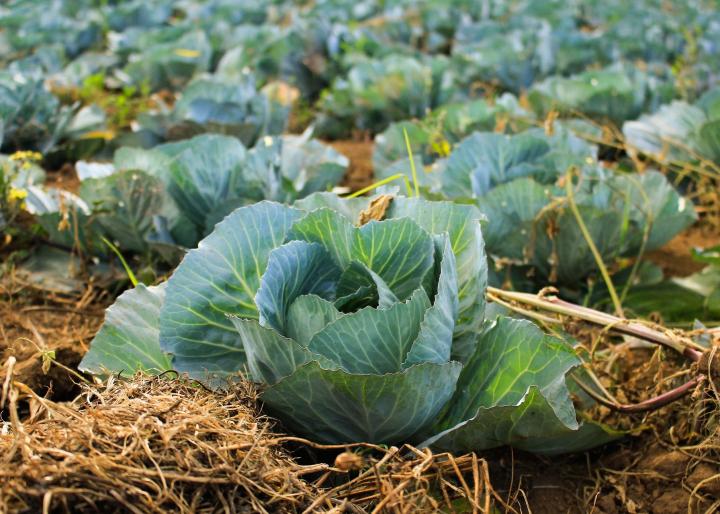Cabbage Seed Rate and the Best Time of Sowing

Cabbage is a hardy, leafy vegetable full of vitamins. By planning your growing season and providing diligent care, you may have two successful crops in one year, in both spring and fall. Here is our guide for planting, growing, and harvesting cabbage.
Cabbage is a hardy, leafy vegetable full of vitamins. By planning your growing season and providing diligent care, you may have two successful crops in one year, in both spring and fall. Here is our guide for planting, growing, and harvesting cabbage.
Mark Twain once said, “Cauliflower is nothing but cabbage with a college education.” In fact, cabbage is no longer seen so poorly. We now know that this hardy vegetable is antioxidant- and nutrient-rich, and a great addition to any garden!
That said, note that cabbage can be difficult to grow for the beginner gardener; it only likes cool temperatures and it can be a magnet for some types of garden pests. Rotating the cabbage crop every few years will help avoid a buildup of soilborne diseases.
Many varieties are available to suit both your growing conditions and taste preferences.
PLANTING
- Cabbage is a heavy feeder; it quickly depletes the soil of the required nutrients.
- Prepare the soil in advance by mixing in aged manure and/or Soil should be well-draining: roots that stand in water cause heads to split or rot.
- If starting seeds indoors, sow ¼ inch deep 6 to 8 weeks before the last spring frost.
- Before planting the seedlings outdoors the plants over the course of a week.
- Transplant small plants outdoors on a cloudy afternoon 2 to 3 weeks before the last spring frost date.
- Plant seedlings 12 to 24 inches apart in rows, depending on the size of the head desired. The closer you plant, the smaller the cabbages.
- For a fall harvest, direct sow seeds outdoors (or plant transplants) in mid- to late summer. If your area is particularly hot and dry, hold off on planting until late summer. Make sure that the young plants don’t dry out in the summer sun’s heat!
CARE
HOW TO GROW CABBAGES
- When seedlings reach about 5 inches tall, thin to leave the desired space between them. If you wish, transplant the thinned seedlings elsewhere.
- Mulch thickly around the area to retain moisture and regulate soil temperature. The optimum soil temperature for growth is 60 to 65° F. Young plants exposed to temperatures below 45°F for a period of time may bolt or form loose heads.
- Fertilize 2 weeks after transplanting with a balanced (10-10-10) fertilizer.
- Three weeks late, add a nitrogen-rich fertilizer; cabbage needs nitrogen in the early stages.
- Practice crop rotation with cabbages to avoid a buildup of soil-borne diseases.

SHARE:
Mark Twain once said, “Cauliflower is nothing but cabbage with a college education.” In fact, cabbage is no longer seen so poorly. We now know that this hardy vegetable is antioxidant- and nutrient-rich, and a great addition to any garden! See 5 reasons to eat cabbage.
That said, note that cabbage can be difficult to grow for the beginner gardener; it only likes cool temperatures and it can be a magnet for some types of garden pests. Rotating the cabbage crop every few years will help avoid a buildup of soilborne diseases.
Many varieties are available to suit both your growing conditions and taste preferences.
PLANTING
- Cabbage is a heavy feeder; it quickly depletes the soil of the required nutrients.
- Prepare the soil in advance by mixing in aged manure and/or compost. Soil should be well-draining: roots that stand in water cause heads to split or rot.
- If starting seeds indoors, sow ¼ inch deep 6 to 8 weeks before the last spring frost. Consult our Planting Calendar for suggested dates.
- Before planting the seedlings outdoors, harden off the plants over the course of a week.
- Transplant small plants outdoors on a cloudy afternoon 2 to 3 weeks before the last spring frost date.
- Plant seedlings 12 to 24 inches apart in rows, depending on the size of the head desired. The closer you plant, the smaller the cabbages.
- For a fall harvest, direct sow seeds outdoors (or plant transplants) in mid- to late summer. If your area is particularly hot and dry, hold off on planting until late summer. Make sure that the young plants don’t dry out in the summer sun’s heat!

CARE
HOW TO GROW CABBAGES
- When seedlings reach about 5 inches tall, thin to leave the desired space between them. If you wish, transplant the thinned seedlings elsewhere.
- Mulch thickly around the area to retain moisture and regulate soil temperature. The optimum soil temperature for growth is 60 to 65° F. Young plants exposed to temperatures below 45°F for a period of time may bolt or form loose heads.
- Fertilize 2 weeks after transplanting with a balanced (10-10-10) fertilizer.
- Three weeks late, add a nitrogen-rich fertilizer; cabbage needs nitrogen in the early stages.
- Practice crop rotation with cabbages to avoid a buildup of soil-borne diseases.
PESTS/DISEASES
Some old folklore tells us: Scatter elder leaves over your cabbage to keep the bugs away.
- Aphids
- Cabbage Loopers
- Cabbage Root Maggots
- Imported cabbage worms
- Clubroot
- Cutworms
- Flea Beetles
- Downy Mildew
- Slugs/Snails
- Stinkbugs
- Thrips


